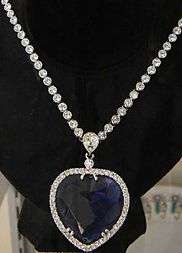Heart of the Ocean
The Heart of the Ocean (also known as Le Cœur de la Mer) is the name of a fictional blue diamond featured prominently in the 1997 film Titanic. In the story, the diamond was originally owned by Louis XVI and cut into a heart shape after the French Revolution. Caledon Hockley (Billy Zane), the wealthy son of a Pittsburgh steel tycoon, purchased the diamond for his fiancée Rose DeWitt Bukater (Kate Winslet) a week before they sailed on Titanic.
Origin
The story of the Hope Diamond bears many similarities to the story of the Heart of the Ocean (obviously the Hope Diamond was never actually on board the Titanic). In the 1943 film Titanic, a blue diamond plays an important role in a love affair as well. A primary plot point in this earlier film is the theft of the diamond, which creates a dramatic break in a romantic relationship also similar to the 1997 film.
1997 film

In the 1997 film fictional treasure hunter Brock Lovett (Bill Paxton) searches for a diamond necklace, which he believes lies within the wreck of the RMS Titanic. Lovett reveals that the necklace was fashioned from a large blue diamond worn by Louis XVI. Shortly after the King's execution in 1793, the diamond was recut into a heart and became known as The Heart of the Ocean. Lovett states that the Heart of the Ocean was 56 carats, which would make it more valuable than the Hope Diamond which is 45 carats. The story of the Heart of the Ocean is similar to the story of the Hope Diamond, except the Hope Diamond was worn by Louis XIV in a royal necklace rather than a crown. Lovett's hunch about the diamond's whereabouts seems to be confirmed when his team salvages a drawing in which a nude woman is wearing the necklace. The drawing is dated April 14, 1912, the day the Titanic sank.
Later on an elderly woman (Gloria Stuart) claiming to be the woman in the picture contacts Lovett and is flown out to his recovery ship. The elderly woman tells the story of her voyage on the ill fated ocean liner Titanic. She reveals that although now known as Rose Dawson Calvert, she was once Rose DeWitt Bukater. During the film the audience's perspective alternates between the past and present as Rose shares her memories. Rose relates the details of the night she wore the necklace and her relationship with the artist of the drawing, Jack Dawson (Leonardo DiCaprio).
It is not thoroughly stated whether or not Rose (Gloria Stuart) told Brock Lovett that before the Titanic sank, Caledon emptied his safe placing the diamond in his coat. This is the very coat that he later put on Rose forgetting about the precious gem in its pocket. At the end of the film, Rose walks alone to the stern of the salvage ship and opens her hands to reveal the necklace. Rose flashes back to her past arriving in New York still wearing the coat, she discovers the necklace in her pocket. Rose flashes back to the present and with a smile, she throws the necklace from her hand into the water presumably above the Titanic wreck site.[2]
Design
London-based jewelers Asprey & Garrard used cubic zirconias set in white gold[3] to create an Edwardian-style necklace to be used as a prop in the film. Asprey & Garrard produced and designed the necklaces: the result was three different and unique designs. Two of their designs were used in the film while the other went unused until after the film had been released. The three necklaces are commonly known as the original prop, the J. Peterman necklace, and the Asprey necklace. The three necklaces are all very similar but have distinguishable differences.
The Original Necklace
The original necklace was the necklace seen throughout the film. This necklace has a large London-blue stone cut into a trillion/cleftless heart surrounded by white round cut cubic zirconias set in white gold. The chain is composed of a mix of round, pear, and marquise cut white cubic zirconias. The bail on this necklace was a heart cut white cubic zirconia attached to a white round cut stone which was attached to the cage on the main stone. The whereabouts of the original necklace is largely unknown though it is believed to be in the possession of 20th Century Fox. There has never been an official statement on the necklace as it has never been made available for public viewing.
The J. Peterman Necklace
Due to The J. Peterman Company's acquisition of this particular necklace through the sale of props from the film, this design is often referred to as the J. Peterman design, though officially the necklace does not hold this designation. This particular design is another blue cubic zirconia; however, it is cut into the shape of a heart rather than a trillion cut. The main stone is surrounded by round cut cubic zirconias and features a white round cut stone at the top where it attaches to the chain. The chain is composed of white round cut cubic zirconias, with a larger inverted pear cut cubic zirconia as the bail. This particular design is featured in the film for a brief moment when Caledon retrieves the necklace from his safe during the sinking, this is the only time the necklace is seen on screen. This particular necklace is believed to still be in the possession of the J. Peterman Company.
The Asprey & Garrard Necklace
The third and final design was not used in the film. After the film's success, Asprey & Garrard were commissioned to create an authentic Heart of the Ocean necklace using the original design. The result was a platinum-set, 171-carat (34.2 g) heart-shaped Ceylon sapphire surrounded by 103 diamonds.[3] This design featured a much larger inverted pear shaped Ceylon sapphire with a subtle cleft to resemble a heart. The chain for this necklace also featured a mix of round, pear, and marquise cut white diamonds. The bail also featured a heart cut white diamond with another round cut diamond attached to an inverted pear shape diamond which was then attached to the cage of the main stone. The necklace was donated to Sotheby's auction house in Beverly Hills for an auction benefiting the Diana, Princess of Wales Memorial Fund and Southern California's Aid For AIDS. It was sold to an unidentified Asprey client[4] for $1.4 million, under the agreement that Celine Dion would wear it two nights later at the 1998 Academy Awards ceremony. This necklace has also never been made available for public viewing

Reproductions
After the release of the film in 1998, The J. Peterman Company sold less expensive reproductions. Their necklace consisted of 137 Austrian crystals and a detachable, inauthentic "blue diamond" pendant packaged in a navy blue, hinged presentation box.[5] This is the only officially licensed reproduction of the necklace. This particular replica can still be found on the secondary market, although likely in used condition.
There are many other unofficial inspired reproductions available on the secondary market ranging in price from as little as $5 to thousands of dollars.
References
- ↑ Schultz, Rick. "James Cameron tells the astonishing story of Titanic, his breathtaking labor of love". industrycentral.net. Retrieved January 23, 2010.
- ↑ Clarke, James (14 May 2014). The Cinema of James Cameron: Bodies in Heroic Motion. Columbia University Press. p. 127. ISBN 978-0-231-85062-9.
- 1 2 Davidson, Terry (March 11, 1998). "Real 'Titanic' Necklace to Benefit Diana's Trust: Movie's Paste Necklace Recreated with Real Jewels" (Interview). Interview with Diane Sawyer.
- ↑ Van Der Voort, Jane (February 11, 2001). "Heart Of The Matter". The Toronto Sun.
- ↑ "J. Peterman Co. Finds Merchandising 'Jewel' in 'Titanic'; 'Heart of the Ocean' Necklace To Be Sold Through Company's Catalog". Business Wire. March 23, 1998.